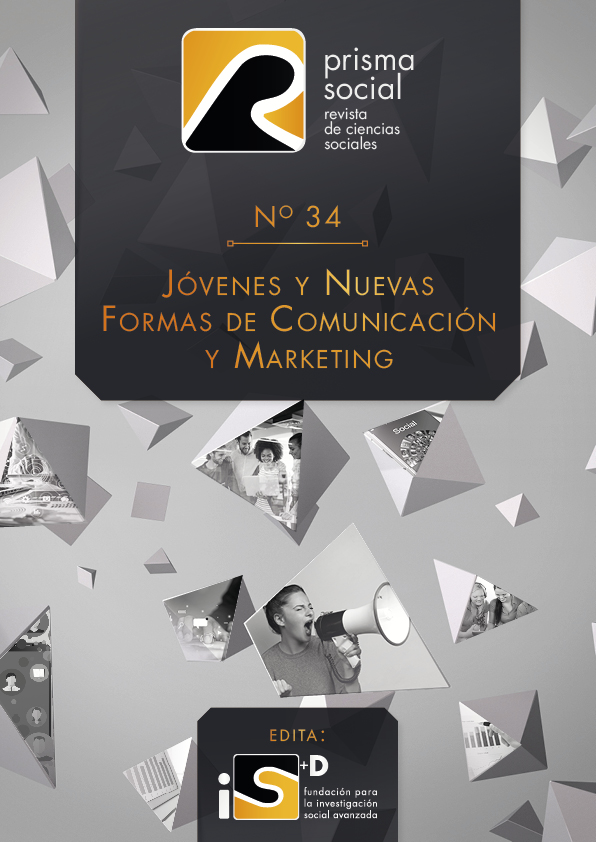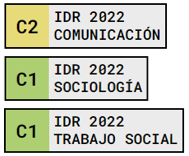Realidad Virtual, videojuegos y publicidad in-game
Un estudio experimental en el colectivo adolescente con implicaciones empresariales para la industria del entretenimiento
Palabras clave:
Adolescencia, experimento, videojuego, realidad virtual, brand placement, in-game advertising, atenciónResumen
En la actualidad, el colectivo adolescente es «nativo digital», es decir, son individuos que han nacido y crecido con la tecnología. Desde la comunicación publicitaria, el salto hacia la digitalización es la única forma de alcanzar la atención de este público. En este estudio de naturaleza experimental se observa en 228 adolescentes, su comportamiento atencional ante un videojuego que utiliza brand placement (emplazamiento de marca) e incorpora realidad virtual, ámbito con escasas investigaciones en este colectivo, y se recaba la información con un cuestionario. Se elige esta estrategia publicitaria por no ser invasiva y poderse integrar en el medio fácilmente, convencional o no convencional en este caso, un videojuego. Se cree la realidad virtual procurará mejores resultados, por estar acorde con las preferencias de los/las adolescentes. Analizando los resultados desde las limitaciones en la atención de los/las adolescentes y utilizando la RV, se observa que existe un solapamiento de tareas cognitivas, a mayor cercanía de la marca durante el juego, mejores resultados en los recuerdos y en las actitudes hacia la marca. Es decir, se crea un solapamiento en el procesamiento de tareas a las que atender, mejorando su atención respecto a localizaciones más lejanas de la marca.
Descargas
Citas
Adachi, P. J. C., & Willoughby, T. (2016). Does playing sports video games predict increased involvement in real-life sports over several years among older adolescents and emerging adults? Journal of Youth and Adolescence, 45(2), 391–401. https://doi.org/10.1007/s10964-015-0312-2.
Aliagas, I., Privado, J., & Merino, M. D. (2021). Proximity, Familiarity or Congruency? What influences memory of brand placement in videogames. Journal of Theoretical and Applied Electronic Commerce Research, 16(4), 811–827. https://doi.org/10.3390/jtaer16040046.
Berenguel, J. (2005). Product placement estrella invitada: La marca. Comunicación: Revista Internacional de Comunicación Audiovisual, Publicidad y Estudios Culturales, 3, 281–285. https://idus.us.es/bitstream/handle/11441/57658/product_placement_estrella_invitada_la_marca.pdf?sequence=1&isAllowed=y.
Besharat, A., Kumar, A., Lax, J. R., & Rydzik, E. J. (2013). Leveraging Virtual Attribute experience in video games to improve brand recall and learning. Journal of Advertising, 42(2–3), 170–182. https://doi.org/10.1080/00913367.2013.774593.
Bioulac, S., de Sevin, E., Sagaspe, P., Claret, A., Phillip, P., Micoulaud-Franchi, J. A., & Bouvard, M. P. (2017). What do virtual reality tools bring to child and adolescent psychiatry. L´Encephale, 44(3), 280–285. https://doi.org/10.1016/j.encep.2017.06.005.
Blakemore, S. J., Burnett, S., & Dahl, R. E. (2010). The role of puberty in the developing adolescent brain. Human Brain Mapping, 31(6), 926–933. https://doi.org/10.1002/hbm.21052.
Brown, C. A., Revette, A. C., de Ferranti, S. D., Fontenot, H. B., & Gooding, H. C. (2021). Conducting web-based focus groups with adolescents and young adults. International Journal of Qualitative Methods, 20, 160940692199687. https://doi.org/10.1177/1609406921996872.
Bruya, B., & Tang, Y. Y. (2018). Is Attention Really Effort? Revisiting Daniel Kahneman’s Influential 1973 Book Attention and Effort. Frontiers in Psychology, 9. https://doi.org/10.3389/fpsyg.2018.01133.
Burkhalter, J. N., Curasi, C. F., Thornton, C. G., & Donthu, N. (2017). Music and its multitude of meanings: Exploring what makes brand placements in music videos authentic. Journal of Brand Management, 24(2), 140–160. https://doi.org/10.1057/s41262-017-0029-5.
Colás-Bravo, P., & Quintero-Rodríguez, I. (2020). Respuesta de los/las adolescentes hacia una campaña de realidad virtual sobre violencia de género. Prisma Social: Revista de Ciencias Sociales, 30, 186–206. Recuperado de: https://revistaprismasocial.es/article/view/3695/4356.
De Jans, S., Hudders, L., & Cauberghe, V. (2018). Adolescents’ self-reported level of dispositional advertising literacy: how do adolescents resist advertising in the current commercial media environment? Young Consumers, 19(4), 402–420. https://doi.org/10.1108/yc-02-2018-00782.
Ernst, M., Benson, B., Artiges, E., Gorka, A. X., Lemaitre, H., Lago, T., Miranda, R., Banaschewski, T., Bokde, A. L. W., Bromberg, U., Brühl, R., Büchel, C., Cattrell, A., Conrod, P., Desrivières, S., Fadai, T., Flor, H., Grigis, A., Gallinat, J., . . . Martinot, J. L. (2019). Pubertal maturation and sex effects on the default-mode network connectivity implicated in mood dysregulation. Translational Psychiatry, 9(1). https://doi.org/10.1038/s41398-019-0433-6.
Ferguson, C. J., & Donnellan, M. B. (2017). are associations between “sexist” video games and decreased empathy toward women robust? A reanalysis of Gabbiadini et al. 2016. Journal of Youth and Adolescence, 46(12), 2446–2459. https://doi.org/10.1007/s10964-017-0700-x.
Google. (2017). It´s lit: A guide to what teens think is cool. Recuperado de: https://storage.googleapis.com/think/docs/its-lit.pdf.
Guerrero Cuevas, B., & Valero Aguayo, L. (2013). Efectos secundarios tras el uso de realidad virtual inmersiva en un videojuego. International Journal of Psychology and Psychological Therapy, 13(2), 163–178. Recuperado de: https://www.ijpsy.com/volumen13/num2/353/efectos-secundarios-tras-el-uso-de-realidad-ES.pdf.
Herrewijn, L., & Poels, K. (2014). Recall and recognition of in-game advertising: the role of game control. Frontiers in Psychology, 4. https://doi.org/10.3389/fpsyg.2013.01023.
Herting, M. M., & Chu, X. (2017). Exercise, cognition, and the adolescent brain. Birth Defects Research, 109(20), 1672–1679. https://doi.org/10.1002/bdr2.1178.
Kahneman, D. (1973). Attention and effort. Prentice Hall.
Lang, A. (2000). The limited capacity model of mediated message processing. Journal of Communication, 50(1), 46–70. https://doi.org/10.1111/j.1460-2466.2000.tb02833.x.
Lee, M., & Faber, R. J. (2007). Effects of product placement in on-line games on brand memory: A perspective of the limited-capacity model of attention. Journal of Advertising, 36(4), 75–90. https://doi.org/10.2753/joa0091-3367360406.
Leonhardt, M., & Overå, S. (2021). Are there differences in video gaming and use of social media among boys and girls? A Mixed Methods Approach. International Journal of Environmental Research and Public Health, 18(11), 6085. https://doi.org/10.3390/ijerph18116085.
Mills, K. L. (2016). possible effects of internet use on cognitive development in adolescence. Media and Communication, 4(3), 4–12. https://doi.org/10.17645/mac.v4i3.516.
Muros-Ruiz, B., Aragón-Carretero, Y., & Bustos-Jiménez, A. (2013). Youth’s usage of leisure time with video games and social networks. Comunicar, 20(40), 31–39. https://doi.org/10.3916/c40-2013-02-03.
Mustonen, T., Berg, M., Kaistinen, J., Kawai, T., & Häkkinen, J. (2013). Visual task performance using a monocular see-through head-mounted display (HMD) while walking. Journal of Experimental Psychology: Applied, 19(4), 333–344. https://doi.org/10.1037/a0034635.
Nelson, M. R., Yaros, R. A., & Keum, H. (2006). Examining the influence of telepresence on spectator and player processing of real and fictitious brands in a computer game. Journal of Advertising, 35(4), 87–99. https://doi.org/10.2753/joa0091-3367350406.
Nguyen, M., Tran, H., & Le, H. (2017). Exploration of the 3d world on the internet using commodity virtual reality devices. Multimodal Technologies and Interaction, 1(3), 15. https://doi.org/10.3390/mti1030015.
Niño González, J. I., Cuesta Cambra, U., & Martínez Martínez, L. (2019). Publicidad in-game (IGA): un análisis exploratorio de patrones de personalidad y de respuesta biométrica mediante expresión facial, GSR y eye-tracking. Prisma Social: Revista de Ciencias Sociales, 26, 116–130. Recuperado de: https://revistaprismasocial.es/article/view/3088/3317.
PEGI. (2019). Pan European Game Information. Recuperado de: https://bit.ly/2WwboqJ.
Redondo, I. (2012). The effectiveness of casual advergames on adolescents’ brand attitudes. European Journal of Marketing, 46(11/12), 1671–1688. https://doi.org/10.1108/03090561211260031.
Rodríguez Rodríguez, M., & García Padilla, F. M. (2021). El uso de videojuegos en adolescentes. Un problema de Salud Pública. Enfermería Global, 20(2), 557–591. https://doi.org/10.6018/eglobal.438641.
Schomaker, J. (2019). Unexplored territory: Beneficial effects of novelty on memory. Neurobiology of Learning and Memory, 161, 46–50. https://doi.org/10.1016/j.nlm.2019.03.005.
Schwartz, D., Kelleghan, A., Malamut, S., Mali, L., Ryjova, Y., Hopmeyer, A., & Luo, T. (2019). Distinct modalities of electronic communication and school adjustment. Journal of Youth and Adolescence, 48(8), 1452–1468. https://doi.org/10.1007/s10964-019-01061-8.
Ruiz, D., & Martín-Ramallal, P. (2019). Realidad virtual, publicidad y menores de edad. Revista ICONO14 Revista científica de Comunicación y Tecnologías emergentes, 17(1), 83–110. https://doi.org/10.7195/ri14.v17i1.1234.
Slater, A., Halliwell, E., Jarman, H., & Gaskin, E. (2017). more than just child’s play? An experimental investigation of the impact of an appearance-focused internet game on body image and career aspirations of young girls. Journal of Youth and Adolescence, 46(9), 2047–2059. https://doi.org/10.1007/s10964-017-0659-7.
Uriel, E. (1995). Análisis de datos: Series temporales y análisis multivariante. S.A. Alfa Centauro.
Van Berlo, Z. M., van Reijmersdal, E. A., Smit, E. G., & van der Laan, L. N. (2021). Brands in virtual reality games: Affective processes within computer-mediated consumer experiences. Journal of Business Research, 122, 458–465. https://doi.org/10.1016/j.jbusres.2020.09.006.
Vashist, D. (2018). Effect of product involvement and brand prominence on advergamers’ brand recall and brand attitude in an emerging market context. Asia Pacific Journal of Marketing and Logistics, 30(1), 43–61. https://doi.org/10.1108/apjml-01-2016-0014.
Wang, D. (2017). Gamified learning through unity 3D in visualizing environments. Neural Computing and Applications, 29(5), 1399–1404. https://doi.org/10.1007/s00521-017-2928-5.
Descargas
Publicado
Cómo citar
Número
Sección
Licencia
Derechos de autor 2021 Revista Prisma Social

Esta obra está bajo una licencia internacional Creative Commons Atribución-NoComercial-SinDerivadas 4.0.
Los autores/as que publiquen en esta revista aceptan las siguientes condiciones:
- Los autores/as conservan los derechos de autor.
- Los autores/as ceden a la revista el derecho de la primera publicación. La revista también posee los derechos de edición.
- Todos los contenidos publicados se regulan mediante una Licencia Atribución/Reconocimiento-SinDerivados 4.0 Internacional. Acceda a la versión informativa y texto legal de la licencia. En virtud de ello, se permite a terceros utilizar lo publicado siempre que mencionen la autoría del trabajo y a la primera publicación en esta revista. Si transforma el material, no podrá distribuir el trabajo modificado.
- Los autores/as pueden realizar otros acuerdos contractuales independientes y adicionales para la distribución no exclusiva de la versión del artículo publicado en esta revista (p. ej., incluirlo en un repositorio institucional o publicarlo en un libro) siempre que indiquen claramente que el trabajo se publicó por primera vez en esta revista.
- Se permite y recomienda a los autores/as a publicar su trabajo en Internet (por ejemplo en páginas institucionales o personales), una vez publicado en la revista y citando a la misma ya que puede conducir a intercambios productivos y a una mayor y más rápida difusión del trabajo publicado (vea The Effect of Open Access).


















